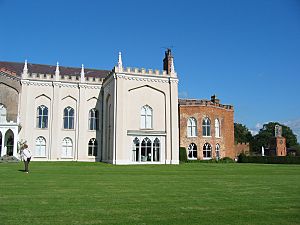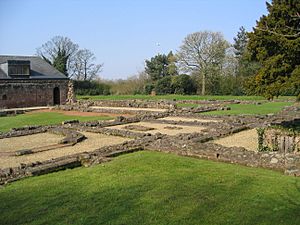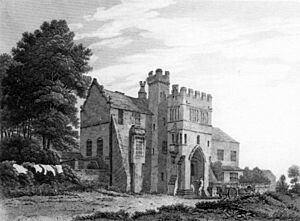List of monastic houses in Cheshire facts for kids
This article lists the monastic houses in Cheshire, England. Monastic houses were special places where groups of people, like monks or nuns, lived together. They dedicated their lives to religious practices, prayer, and often worked to help their communities. These places were very important in medieval times.
Contents
- What are Monastic Houses?
- Monastic Houses in Cheshire
- Barrow Camera
- Chester Abbey (now Chester Cathedral)
- Chester Abbey (St John the Baptist)
- Chester Blackfriars
- Chester Franciscan Friary
- Chester Greyfriars
- Chester Friars of the Sack
- Chester — St Michael's Monastery
- Chester Whitefriars
- Chester Priory (St Mary)
- Combermere Abbey
- Curzon Park Abbey, Chester
- Darnhall Abbey
- Mobberley Priory
- Norton Priory
- Poulton Abbey
- Runcorn Priory
- Saighton Grange
- Stanlow Abbey
- Stanney Grange
- Vale Royal Abbey
- Warrington Austin Friars
- Images for kids
- See also
What are Monastic Houses?
Monastic houses include different types of religious communities. Monks lived in abbeys or priories, while nuns lived in convents or priories. Friars were different; they often traveled and preached, living in friaries. These communities followed strict rules and played a big role in education, healthcare, and farming.
Types of Religious Communities
- Monks: Men who lived apart from the world in monasteries. They followed rules like the Rule of Saint Benedict.
- Nuns: Women who lived in convents or nunneries, similar to monks but for women.
- Canons Regular: Priests who lived in communities under a religious rule, often connected to a church.
- Friars: Members of religious orders who lived among people, often begging for food. Examples include Dominicans (Blackfriars) and Franciscans (Greyfriars).
- Knights Hospitaller: A military and religious order that cared for sick pilgrims and defended Christian lands.
The Dissolution of Monasteries
Many of these monastic houses were closed down in the 1530s. This event is known as the Dissolution of the Monasteries. King Henry VIII ordered this to gain wealth and power. After this, many buildings were destroyed or changed for other uses.
Monastic Houses in Cheshire
Here's a look at some of the important monastic houses that once existed or still exist in Cheshire:
Barrow Camera
This was a place linked to the Knights Hospitaller. It was given to them by Robert de Bachepuz. However, some historians think this might be a mistake and it was actually in Derbyshire.
Chester Abbey (now Chester Cathedral)
- Early History: There might have been a community of nuns here before 875. It was possibly destroyed by Viking raids.
- Secular Canons: After 907, a group of secular canons (priests living in a community) started here.
- Benedictine Monks: In 1092 or 1093, it became an abbey for Benedictine monks. This was thanks to Hugh I, Earl of Chester.
- Dissolution and Today: It was closed in 1540. In 1541, it became the Cathedral Church of Christ and the Blessed Virgin Mary. It is still a cathedral today.
Chester Abbey (St John the Baptist)
- Early History: This site might have had secular canons as early as 689. It was possibly destroyed by Danes after 875.
- Refoundation: It was refounded around 906-907.
- Cathedral Role: For a short time (around 1072-1102), it served as a cathedral.
- Later Use: From 1102, it became a parish church. It was closed in 1547.
Chester Blackfriars
- Dominican Friars: This friary was home to Dominican Friars. They were also known as Blackfriars because of their dark robes.
- Foundation: It was founded before 1236 by Alexander Stavensby, a bishop.
- Dissolution: It was closed in 1538. The land was later sold.
Chester Franciscan Friary
- Capuchin Franciscan Friars: This community of Capuchin Franciscan Friars started in 1858 at an earlier site.
- New Site: They moved to their current site in 1862.
- Still Active: The church here opened in 1875 and is still in use today.
Chester Greyfriars
- Franciscan Friars: This was a home for Franciscan Friars Minor, also known as Greyfriars.
- Foundation: It was founded around 1237-1240.
- Dissolution: It was closed in 1537 or 1538.
Chester Friars of the Sack
- Friars of the Sack: This was a small community of Friars of the Sack.
- Short-lived: They were founded before 1274 but closed down quickly in 1284. The community likely died out before 1300.
Chester — St Michael's Monastery
- Uncertain Order: It's not clear what kind of religious order lived here.
- Foundation: It was founded before 1162.
- Current Use: The building was rebuilt in the 19th century and is now a Heritage Centre.
Chester Whitefriars
- Carmelite Friars: This was a home for Carmelite Friars, also known as Whitefriars.
- Foundation: They were founded in 1279.
- Dissolution: The friary was closed in 1538.
Chester Priory (St Mary)
- Benedictine Nuns: An earlier community of Benedictine nuns existed before 1066.
- Refoundation: They moved and were refounded around 1140 by Ranulph de Gernon, Earl of Chester.
- Dissolution: The priory was closed around 1537. The site was later excavated.
Combermere Abbey
- Savignac Monks: This abbey was first home to Savignac monks, founded in 1133.
- Cistercian Monks: In 1147, the Savignac order merged with the Cistercian monks.
- Dissolution: The abbey was closed in 1538.
Curzon Park Abbey, Chester
- Benedictine Nuns: This is a modern community of Benedictine nuns.
- Transfer: They moved here in 1988 from Talacre in Wales.
- Still Active: This abbey is still active today.
Darnhall Abbey
- Cistercian Monks: This abbey was founded for Cistercian monks by King Edward I between 1271 and 1274.
- Transfer: The community later moved to a new site at Vale Royal Abbey in 1281.
Mobberley Priory
- Augustinian Canons: This priory was for Augustinian Canons Regular.
- Foundation: It was founded around 1203-1204.
- Later Use: It became a smaller part of a larger monastery in Staffordshire. A manor house was built on the site in 1625.
Norton Priory
- Augustinian Canons: The community of Augustinian Canons Regular started in Runcorn around 1115.
- Transfer and Abbey Status: They moved to Norton in 1134. It was later made into an abbey around 1391.
- Dissolution and Museum: It was closed in 1536. Part of it became a private house. Today, it is a museum open to the public.
Poulton Abbey
- Savignac and Cistercian Monks: This abbey was founded for Savignac monks in 1153. They later became Cistercian monks in 1147.
- Transfer: The community moved to Dieulacres in Staffordshire in 1214 because of attacks from the Welsh.
- Later Use: The site was then used as a farm for the monastery. It was ruined by the 17th century.
Runcorn Priory
- Early Foundation: There's a belief that a monastic house was founded here around 912.
- Augustinian Canons: A priory for Augustinian Canons Regular was founded in 1115.
- Transfer: This community later moved to Norton Priory in 1134. The site might be where All Saints parish church is today.
Saighton Grange
- Benedictine Monks: This was a large farm (grange) for Benedictine monks from Chester Abbey.
- Residential Use: In the 15th century, it became a home for the abbots of Chester.
- Current Use: Most of the old buildings were taken down in 1861. A new house was built, which became a school called 'Abbey Gate College' in 1977.
Stanlow Abbey
- Cistercian Monks: This abbey was for Cistercian monks, founded in 1172.
- Transfer: The community moved to Whalley in Lancashire in 1296.
- Later Use: It was still used as a smaller part of Whalley Abbey until 1442. Today, there are no major remains.
Stanney Grange
- Cistercian Monks: This was another farm (grange) for Cistercian monks. It was connected to Stanlow Abbey.
- Foundation: It was founded in 1172.
Vale Royal Abbey
- Cistercian Monks: The community of Cistercian monks started at Darnhall Abbey.
- Transfer: They moved to Vale Royal in 1281. King Edward I planned for it to be a very grand abbey, but it was never fully finished.
- Dissolution: It was closed in 1545.
Warrington Austin Friars
- Augustinian Friars: This friary was for Augustinian Friars.
- Foundation: It was founded before 1272, possibly built in 1379, on the site of an older hospital.
- Dissolution: It was closed in 1539. The church was used until the 17th century.
Images for kids
See also











